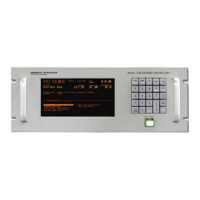Operation
5.8.3 Clear/Correct System Faults Function
Clear/correct system faults clears all faults that can be cleared, and acknowledges
faults that the ACU cannot correct. If there are unacknowledged faults:
• All faults are displayed in reverse video (even if some faults had been
previously acknowledged). If all faults displayed have been acknowledged,
they are displayed in normal video.
• If the audible alarms are on (refer to Section 5.8.6.14), the ACU will emit a
steady tone -- acknowledging the faults will deactivate the alarms.
• The summary alarm contact closure is opened. When all faults are cleared
and/or acknowledged, this contact will close.
Some faults can only be acknowledged by the ACU; action external to the ACU is
required to clear the fault (e.g., if the EMERGENCY STOP button on the drive
cabinet is engaged, the button must be disengaged at the drive cabinet before the
fault can be cleared.)
Some faults are "latching"; that is, even though the fault condition has been
cleared, the user must acknowledge that the fault occurred before the fault
message will disappear from the ACU display. An example of a latching fault is the
"Tracking signal input saturated" fault message, indicating that the tracking signal
input exceeded 10 VDC. The ACU cannot track properly with that voltage. This
latches because this error often occurs intermittently. Since this can cause
intermittent tracking problems, it is important to be aware of such a fault so that it
can be corrected.
To clear system faults, return to the Main menu and select Clear/correct system
faults.
5-34

